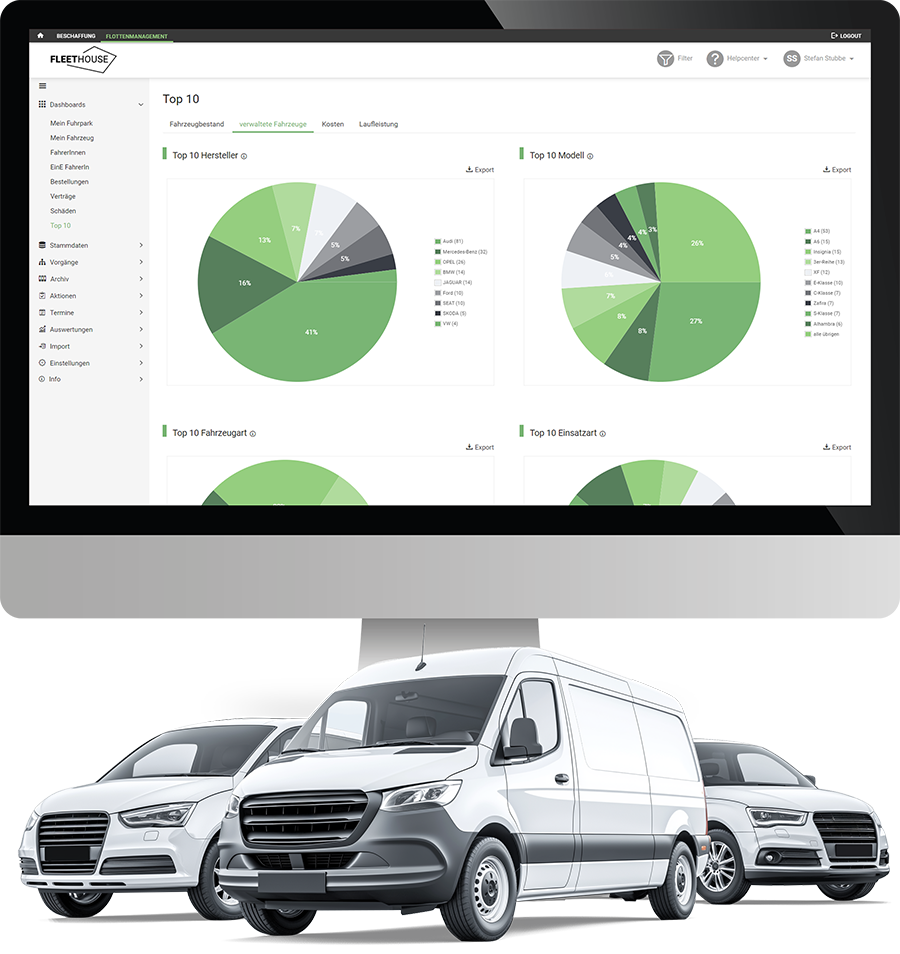The vehicle fleet often represents one of the largest cost blocks for companies. An efficient vehicle fleet is of crucial importance for every company. In order to manage the fleet optimally, make well-founded decisions and reduce costs, meaningful key figures and targeted controlling are essential. In this article, we highlight the five key success factors that give you as an entrepreneur a good overview and what you should pay attention to when it comes to controlling.
Contents
The 5 most important key figures in the fleet
But which key figures are important and how can they contribute to optimizing the fleet? We show you the five most important basic key figures here. Supplement these with the other target key figures, which can vary depending on your company’s activities and objectives. For example, do you want to focus more on alternative mobility, reduce CO2 emissions, reduce mileage or monitor leasing kilometers?
1. vehicle utilization: maximum efficiency through high capacity utilization
Vehicle utilization provides information on how efficiently the fleet is used and how many kilometers are covered per vehicle. High utilization can reduce the costs per kilometer, which has a positive effect on the overall budget. To optimize this key figure, it is advisable to optimize routes, avoid empty runs and match vehicle availability to demand in the best possible way. This is particularly important for pool vehicles – intelligent scheduling allows you to achieve high vehicle utilization and avoid idle times. You can also avoid excess mileage in leasing contracts if this is taken into account when booking and allocating vehicles.
2. fuel consumption: focus on sustainability and cost savings
Another key aspect is fuel consumption. The level of fuel consumption not only influences the company’s environmental footprint, but also its operating costs. Modern fleet management systems can record and evaluate fuel consumption in detail. In order to optimize this value, driver training, the use of more economical vehicles and an anticipatory driving style can be decisive steps. Here you will find 7 tips for saving fuel.

3. maintenance and repair costs: prevention instead of high costs
Unplanned repairs and high maintenance costs can put a considerable strain on the fleet budget. Recording and analyzing maintenance and repair costs makes it possible to react to problems at an early stage and take preventive measures. Regular maintenance and good vehicle care can extend the service life of vehicles and avoid expensive repairs.
4 Fleet age and residual value: finding the optimal replacement time
The age of vehicles and their residual value play an important role in deciding when vehicles should be replaced. Excessive age can lead to rising maintenance and repair costs, while replacing vehicles too early does not fully utilize their residual value. Monitoring this indicator helps to determine the optimal time to replace vehicles and keep the fleet up to date.
5 Accidents and loss frequency: keeping an eye on safety and costs
Accidents not only cause direct costs due to repairs, but can also lead to business interruptions and staff absences. Recording the frequency of accidents makes it possible to identify risk factors and take targeted safety measures. The promotion of safe driving behavior and the use of modern safety technology can help to reduce the number of accidents and thus save costs.
You can read more about this topic in our article: Reducing the claims ratio and saving costs in the vehicle fleet
Fleet controlling with software support
In smaller companies, an Excel spreadsheet is often used to record all fleet data manually. This manual work is not only cumbersome, but also harbors the risk of errors. Errors must be avoided, especially when it comes to something as important as cost control. In addition, the data comes from different sources, which makes the work even more difficult. In addition to costs and contracts, the data also comes from depreciation, fuel card statements and insurance documents. In order to identify optimization potential and uncover cost drivers, it is therefore essential to establish a well-networked reporting system. Software that bundles and automatically evaluates all data provides valuable support.

Fleethouse - The software for your fleet
Manage all tasks relating to your vehicles and keep your fleet costs under control with helpful evaluations.
Key figures in the fleet - 5 steps to efficient controlling
To set up a reporting system, you should identify the most important key performance indicators (KPIs) and monitor them regularly. To do this, follow the five steps below:
- What key figures do you need to achieve your corporate goals? What is important to you – cost reduction, high availability, ecology?
- Which key performance indicators (KPIs) are particularly important to you? Only define as many KPIs as you can monitor clearly.
- Where does the data come from – leasing statements, fuel card statements, insurance policies?
- Carry out regular monitoring to identify weak points, derive measures and finally evaluate whether the measures are achieving the desired effects.
- Sensitize your employees to ensure sustainable success.
Monitor key figures in Fleethouse fleet management
Manual reporting and controlling quickly becomes complicated and error-prone. In Fleethouse, all recorded vehicle data, incoming invoices and mileages are displayed in dashboards and reports. This allows you to see the current status of key figures, period comparisons, outliers due to vehicle comparisons and much more at a glance. This saves an enormous amount of time in controlling and ensures long-term success.
Arrange an online consultation appointment
Arrange your personal consultation appointment now. You can easily select a suitable appointment using our booking tool.

Anne Fuchs

Ciara Lazeta
The most important facts about optimization and key figures in the fleet
The targeted recording and evaluation of key performance indicators can reduce costs, minimize environmental impact and increase safety.
A modern fleet management system supports companies in recording and evaluating the relevant data.
If targeted measures are taken and investments made, the vehicle fleet can be continuously optimized.
Further Fleet Knowledge
If you liked this article and would like to know more about this topic, we recommend these articles.

Fuel cards for companies: Advantages, functions and tips for use




